Earlier in the year, I interviewed Brian Rosenbaum about how his professional training as a social worker and his personal DEI journey have enhanced his ability to fundraise for nonprofits and engage with major donors. During our Q&A, he emphasized the importance of ethical storytelling, which he defined as:
(1) Truthfully representing stories and situations in a way that educates the audience about the systemic and structural issues that challenge people; and
(2) Seeing the client as the teacher and the expert on their own experiences, with both strengths and struggles.
As a fundraising firm, Elevate recognizes the responsibility we have to help our nonprofit partners be better at raising money and supporting their communities while using language that honors the dignity and autonomy of the people and communities they serve.
The Origins of the Ethical Storytelling Movement – Ensuring Stories Do No Harm
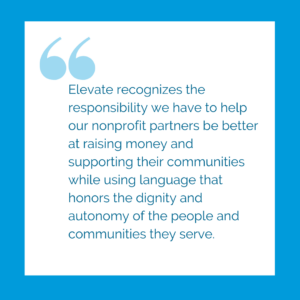 Stories—whether shared verbally, in writing, or through images—have the power to move people to take action. But with this potential to persuade, there is also a high risk of incorporating bias into narratives. Storytellers have the power – whether intentional or not – to inflict harm on the people who are the subjects of their stories.
Stories—whether shared verbally, in writing, or through images—have the power to move people to take action. But with this potential to persuade, there is also a high risk of incorporating bias into narratives. Storytellers have the power – whether intentional or not – to inflict harm on the people who are the subjects of their stories.
When this happens in fundraising, stories can become “transactional”—trading on constituent “suffering” for contributions. If you’ve ever written a grant or a donor appeal letter, you may have been tempted to “tug on the heartstrings” of your reader; in doing so, there is a real risk of telling a story that robs your subject of their dignity.
But there is a different way to originate and tell stories! What if—instead of emotional descriptions of poverty, suffering, or need—your funding requests included stories that celebrated the strengths of a community? What if stories could elevate rather than objectify, and thereby hew closer to the ostensible values and missions of a social-impact organization? It is out of this strength-based rather than deficit-based approach that Rachel Goble, the former CEO The Freedom Story, along with her friends and contacts, brought forward the ethical storytelling movement, along with a dedicated website, EthicalStorytelling.com.
Ethical Storytelling Resources
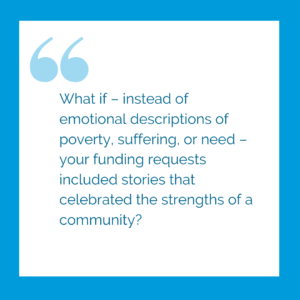 On the EthicalStorytelling.com site, you can find a set of six underlying values, an ethical storytelling pledge, and a collection of resources to guide the storytelling practices of your organization.
On the EthicalStorytelling.com site, you can find a set of six underlying values, an ethical storytelling pledge, and a collection of resources to guide the storytelling practices of your organization.
The pledge urges storytellers to focus on “the HOW, not only the WHAT” of the stories that we encounter—meaning that the process of collecting stories is equally as important as the ultimate content of the stories that are shared. Among others, the pledge includes the commitments to:
- Always put people first.
- Uphold the dignity of constituents through empowering imagery and messages that motivate engagement and inspire hope.
- Truthfully represent a situation or story to educate audiences of the realities, complexities, and nuances of the issues for which you advocate.
- Avoid the use of images, footage, or words that sensationalize or stereotype a person or a situation.
- Ask for feedback from constituents, and incorporate this feedback into the final story.
- Not tell the story, despite the resources invested, when the story cannot be told with the integrity of this pledge.
- Commit to uphold integrity in storytelling and messaging.
The site’s downloadable resources include a child protection policy, a media consent form, and guidance on the use of a victim’s images—valuable tools for any nonprofit organization that wishes to share the stories of the people they serve.
The ethical storytelling approach is aligned with best practices in grant writing and storytelling that employ people-first and strengths-based language. People-first language is language that literally puts the person first. For example, using “a person with diabetes” rather than “diabetic person” when referring to an individual. This framework originated with the disability rights movement and the People with AIDS movement. It has since been reflected in the Americans with Disabilities Act (ADA) and the Individuals with Disabilities Education Act (IDEA).
Keep an eye on this space for more resources on this topic, including examples of Elevate partners that are skillfully applying the principles of ethical storytelling in their work. And for more resources on storytelling, check out Elevate’s previous articles on Using Empowering Language and Inclusive Writing strategies in grants.
At Elevate, we’ve been thinking a lot this year about Artificial Intelligence (AI) and how it could influence the way that we perform our work supporting nonprofits in building more sustainable grants programs. AI is increasingly relevant in everyday business operations across numerous industries, and it has been applied for many years in ways that many people don’t realize – mapping apps like Google Maps, voice assistants like Alexa and Siri, even the autocorrect feature in your texting app or word processing software are powered by artificial intelligence.
Some interesting trends have emerged in 2023, which hint at AI’s potential while also raising significant ethical and information security considerations. A recent Forbes Advisor survey reports that:
- ChatGPT, an AI powered large language model, had 1 million users within the first five days of being available.
- 54% of survey respondents believe that AI tools like ChatGPT can improve written content by enhancing text quality, creativity, and efficiency in various content creation contexts.
- AI is expected to see an annual growth rate of 37.3% between now and 2030.
- The majority of consumers are concerned about business use of AI.
Accordingly, Elevate is treading optimistically – yet cautiously – when it comes to AI! While we are exploring how AI can create efficiencies in our work, we are also committed to maintaining the highest quality and privacy standards for our clients.
I recently spoke with a handful of my most forward-thinking and tech-savvy Elevate colleagues, who offered their thoughts on what AI applications are and aren’t helpful in aspects of their work advising nonprofit clients. We share their insights here for your consideration as we all navigate this brave new world.
Because many of the questions Elevate receives about AI are about ChatGPT specifically, we begin with the 411 on this tool.
Even if you haven’t yet used it yourself, you’ve undoubtedly heard the buzz about ChatGPT. ChatGPT is a free, natural language processing tool that can answer questions and support users with tasks such as composing emails, essays, and code. It can spew out responses in a matter of seconds. It does this by analyzing your question or prompt, then – using the dataset it was trained on – predicting the next word or series of words based on what you’ve entered.
But is it savvy enough to write sophisticated, nuanced, and winning grants?
Our colleagues were unequivocal in their response: Not even close.
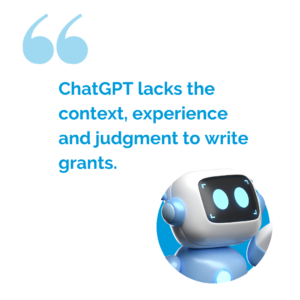 This is because ChatGPT lacks the context, experience and judgment to handle such complex work. Even when I asked ChatGPT “What are the Pros and Cons of Using ChatGPT for grant writing?” it didn’t disagree! While ChatGPT praised its speed and ability to maintain consistency in “tone, language, and messaging” across various sections of a grant proposal and to polish language, it cautioned that it may not fully appreciate the “nuances” of grant guidelines, that it has limitations in understanding the context of an organization’s work and history, and that it could also produce plagiarizing text.
This is because ChatGPT lacks the context, experience and judgment to handle such complex work. Even when I asked ChatGPT “What are the Pros and Cons of Using ChatGPT for grant writing?” it didn’t disagree! While ChatGPT praised its speed and ability to maintain consistency in “tone, language, and messaging” across various sections of a grant proposal and to polish language, it cautioned that it may not fully appreciate the “nuances” of grant guidelines, that it has limitations in understanding the context of an organization’s work and history, and that it could also produce plagiarizing text.
The text that ChatGPT generates in response to a question or prompt might not even be factual – there are absolutely no assurances that the information is accurate or true.
What’s more, because ChatGPT and other AI models draw upon existing content, AI can reflect underlying societal biases, perpetuating stereotypes and white supremacist notions. At Elevate, we know that historically marginalized communities are not “vulnerable” objects of charity, but agents and partners of the social change that they desire to see. This level of social context is far too complex for an AI-powered language model to appropriately reflect.
So, what are the appropriate uses of ChatGPT?
If you do want to experiment with ChatGPT in your writing tasks, we suggest using it for simpler, less analytical tasks, such as condensing word count, identifying alternative phrasing to avoid repetition, or summarizing the main points of your research into more readable language.
ChatGPT also has the potential to provide administrative support for your work, and can be harnessed to:
- Organize a to-do list
- Summarize meeting minutes
- Brainstorm ideas
But whatever you do, do NOT rely on ChatGPT to produce your next grant proposal.
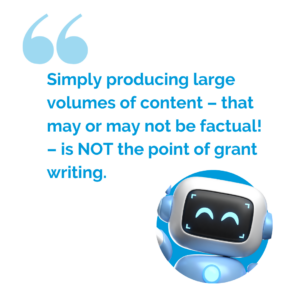 I know what you are thinking: It’s no surprise that a grant writing firm is telling me not to use an AI tool to write grants! But we are not just saying this because we want to be your grant writers. (Though we DO want to be your grant writers!)
I know what you are thinking: It’s no surprise that a grant writing firm is telling me not to use an AI tool to write grants! But we are not just saying this because we want to be your grant writers. (Though we DO want to be your grant writers!)
At Elevate, we firmly believe that good grant writing is a thoughtful, strategic exercise that requires skill, nuance, and informed decision making. ChatGPT – like other AI tools – is neither thoughtful nor strategic. It lacks discernment of nuance, and is incapable of making reasoned choices about how to present an organization’s work to a funding partner.
Simply producing large volumes of content – that may or may not be factual! – is NOT the point of grant writing. And this is truly all that ChatGPT is doing: generating text.
AI Tools CAN Help You Take Notes, Summarize Content, and Find Information
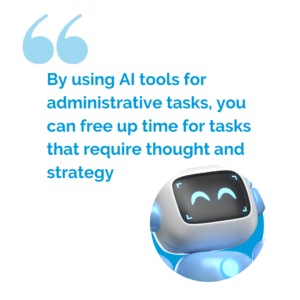 At Elevate, some of our staff are experimenting with the use of AI-powered tools such as Simon Says AI and Fathom Notetaker to capture meeting notes and provide summaries of important conversations that they need to refer back to later or share with colleagues who couldn’t attend meetings. By using AI tools for more administrative tasks, you can free up some of your own time and energy for tasks that require thought and strategy – something AI can’t do!
At Elevate, some of our staff are experimenting with the use of AI-powered tools such as Simon Says AI and Fathom Notetaker to capture meeting notes and provide summaries of important conversations that they need to refer back to later or share with colleagues who couldn’t attend meetings. By using AI tools for more administrative tasks, you can free up some of your own time and energy for tasks that require thought and strategy – something AI can’t do!
As a tool developed by Google, Bard can interface with Google Workspace tools, if you choose to connect these. This means, you can ask Bard to find dates, taks, or other information in gmail, or to summarize a report a colleague shared via Google docs.
Interested in exploring more options for what you can do with AI tools? Check out FutureTools.io, which aggregates AI tools suited for different purposes.
Please Please Please: Inform yourself about privacy!
If you take only one thing away from this article, I hope it is this: get informed about the privacy of the information you share with AI tools, and take precautions to protect your information.
When using any cloud-based technology platform, it is imperative that consideration be given to the way these tools use, store, and share information. Depending on your privacy settings, information you share with tools like Bard and ChatGPT may be used to improve its own language model. This means your data may not only be available to its creators (OpenAI), but also to others who use the platform.
For instance, when first accessing Bard, users are notified that Google will collect conversations and other information like the user’s location, store this data for a period of time, and use it to refine the tool. Furthermore, users are informed that “human reviewers read, annotate, and process your Bard conversations,” and they are warned to not share confidential information.
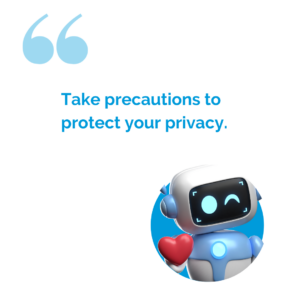 For these reasons, think carefully about what information you share with AI tools. Remember that a grant application may include information about your organization, programs, staff, and future plans that might be considered private. A good rule of thumb is, if you wouldn’t want a piece of data or information on your public website for anyone to find, you should not share that information with an AI tool.
For these reasons, think carefully about what information you share with AI tools. Remember that a grant application may include information about your organization, programs, staff, and future plans that might be considered private. A good rule of thumb is, if you wouldn’t want a piece of data or information on your public website for anyone to find, you should not share that information with an AI tool.
How is your organization using AI powered tools, and what have you found useful, scary, hopeful, or exciting about these tools? We invite you to share!
Are you still feeling overwhelmed, or do you want to learn more? Here are a few sources the team at Elevate is using to stay informed:
Just the grants, please!
Picture It: Grant Writing Nightmares!
Nightmare 1: Imagine, you are the Director of a nonprofit’s small but mighty Development Team. Everything is going swimmingly…until the day your indispensable grant writer sheepishly asks to schedule some catch-up time on your calendar. It turns out they have secured an exciting new career opportunity! You smile winsomely and wish them well, but inside, you just died a little bit. You keep thinking about that overflowing grants calendar and the extra work that is going to fall to you or your other colleagues while things get sorted.
Hiring and training a replacement grant writer is a process. It took you 4 months to find the last one, who stayed with the organization for just over one year. During the last grant writer search, you missed deadlines for important grant reports and renewals. And one long-time funder became irritated with the lack of coordination and pulled their support… Your mind is spinning with all of the worst-case scenarios that simply cannot happen again.

Nightmare 2: Now imagine you are the Development Director for a nonprofit entering into an exciting transitional period. Program staff is in tune with emergent needs of the community and developing exciting and impactful new programs that are resulting in tons of new interest in the organization. The proverbial phone is ringing off the hook with new funders and partners who want to support the organization’s work. The Executive Director and the Board are looking to the Development team to increase revenues in line with program growth. Up until now, you’ve been keeping all those fundraising balls in the air — managing major donors, overseeing the grants calendar, prospecting new funding leads, and planning successful events. But now, you’re starting to wake up in the middle of the night in a cold sweat!
You know that soon, something’s gotta give, whether it is long-term planning, maintaining corporate relationships, or wooing major donors.
QUIZ TIME!
What would you do if you were the Development Director in one of these nightmare scenarios?
A – Text a friend and plan a coffee date to vent about your to-do list.
B – Roll up your sleeves and get to work.
C – Call Elevate!
D – Both A and C
Reclaim Your Time: Elevate’s Ongoing Writing Retainer Service To the Rescue
The correct answer is D, which also stands for “Don’t despair!” That’s because Elevate has got you covered with our Ongoing Writing Retainer Service (OWR)!
Our signature service at Elevate is Comprehensive Grant Writing Services, which offers you a suite of grant program strategy advice and planning, grant calendar and data tracking, project management, prospect research, cultivation support, and full-service grant writing.
While for many organizations this is the solution they need, we’ve learned in our ten years of work with nonprofit clients that, from time to time, organizations simply need a boost in grant writing capacity. In response, we launched a streamlined retainer package in 2022 to help nonprofits through capacity challenges such as the ones described above. We call this service an Ongoing Writing Retainer (OWR).
The OWR matches an organization with a professional grant writer that works to focus exclusively on drafting, editing, and submitting written deliverables – grants, LOIs, and reports – thereby freeing up your internal team’s capacity for other important tasks.
The OWR might be the right Elevate service for you if you already:
- Develop and plan your own annual fundraising goals and strategy;
- Have a planned grants calendar and successfully track all funder deadlines and cultivation history internally;
- Research new funding opportunities, draft funder outreach materials, and track progress toward cultivation targets internally.
The right support at the right time: Elevate and Cavalry Women’s Services
Cavalry Women’s Services, a Washington, DC-based nonprofit that ensures women have access to the proper trauma-informed healthcare and educational support they need to take positive steps toward independence, engaged Elevate for an Ongoing Writing Retainer in early 2023.
Calvary came to Elevate with a solid grants program, at a time when they were planning ahead for their Director of Institutional Advancement to step away from work for a period of leave and a temporary need for capacity to their internal grant writer planned to be away for personal leave. With a strong grants program and a clear calendar of opportunities in place, they sought Elevate’s support to write and submit their grants.
 We paired Calvary with one of our expert grant writers who quickly acquainted themselves with the organization and its programming. Calvary assigned up to four deliverables per month to their Elevate grant writer, including proposals and grant reports.
We paired Calvary with one of our expert grant writers who quickly acquainted themselves with the organization and its programming. Calvary assigned up to four deliverables per month to their Elevate grant writer, including proposals and grant reports.
The Elevate writer met with our point of contact at Calvary briefly on a biweekly or as-needed basis to confirm details and deadlines, receive assignments, and discuss what information was needed to prepare the grants. Elevate handled each step of the drafting process—from planning, drafting, editing, attachment gathering, through to submission. Meanwhile, the team at Calvary was free to focus on other development responsibilities while knowing that their grants submissions could rest in Elevate’s capable hands.
When asked about her experience working with Elevate on an Ongoing Writing Retainer, Heather Laing, Chief Development Officer and our main Point of Contact at Calvary, shared:
“When we had a temporary vacancy on our team, Elevate’s Ongoing Writer Retainer service met our grant writing capacity needs. Elevate was invested in our success in a genuine way, and it was a gift to have a fresh perspective on our grant language.”
Interested in what an Ongoing Writing Retainer or one of Elevate’s other services can do for you? Get in touch so that we can answer your questions, and you can spend more time where your energy is needed most, whether that’s building relationships with your funding partners, implementing your programs, or enjoying more coffee dates with your BFF.
September 21, 2022
Here, we share our team’s top picks for books that have contributed to their grant writing prowess.
 Elevate Grant Writer Amy O’Barr recommends The Only Grant-Writing Book You’ll Ever Need by Ellen Karsh. Amy describes this book as, “A must for any grant writer’s library!” The guide starts at the ground level with grant writing, covering everything from the basics such as vocabulary, up to writing about organizational sustainability. Currently in the 5th edition, readers can be assured that the info is timely and relevant. Bonus: tips from grantmakers!
Elevate Grant Writer Amy O’Barr recommends The Only Grant-Writing Book You’ll Ever Need by Ellen Karsh. Amy describes this book as, “A must for any grant writer’s library!” The guide starts at the ground level with grant writing, covering everything from the basics such as vocabulary, up to writing about organizational sustainability. Currently in the 5th edition, readers can be assured that the info is timely and relevant. Bonus: tips from grantmakers!
 Grant Writer Sam Murphy suggests Good Writing by Connie Snyder Mick for folks who want “a solid refresher on the basics of persuasive writing and argumentative rhetoric.” Often found on syllabi for writing courses, this textbook is designed to equip writers for social action.
Grant Writer Sam Murphy suggests Good Writing by Connie Snyder Mick for folks who want “a solid refresher on the basics of persuasive writing and argumentative rhetoric.” Often found on syllabi for writing courses, this textbook is designed to equip writers for social action.
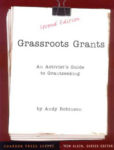 Amy describes Grassroots Grants as “A no-frills classic for grantseekers.” With an emphasis on activism, this guide includes actual proposals and budgets with commentary on what works and what doesn’t. The second edition was published back in 2004, so some of the resources included in this book may be a little outdated. Still, the how-to on grant writing and budgets is spot on for grant writers today.
Amy describes Grassroots Grants as “A no-frills classic for grantseekers.” With an emphasis on activism, this guide includes actual proposals and budgets with commentary on what works and what doesn’t. The second edition was published back in 2004, so some of the resources included in this book may be a little outdated. Still, the how-to on grant writing and budgets is spot on for grant writers today.
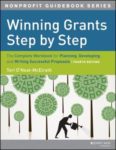 Another recommendation by Amy, Winning Grants Step by Step is a workbook that guides both novice and experienced grant writers through the grant process from organizational readiness to funder networking. Amy says that the “concise format and many worksheets are ideal for organizations starting a grants
Another recommendation by Amy, Winning Grants Step by Step is a workbook that guides both novice and experienced grant writers through the grant process from organizational readiness to funder networking. Amy says that the “concise format and many worksheets are ideal for organizations starting a grants
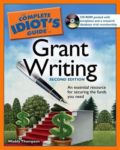 Supervising Director Raquel Braemer, suggests that new grant writers check out The Complete Idiot’s Guide to Grant Writing. She says, “I found this book incredibly helpful. It walks you through every stage in the grant writing process, providing examples and tips along the way. Everything is divided into very clear sections, so you can find some insight or a template quickly when you need one.”
Supervising Director Raquel Braemer, suggests that new grant writers check out The Complete Idiot’s Guide to Grant Writing. She says, “I found this book incredibly helpful. It walks you through every stage in the grant writing process, providing examples and tips along the way. Everything is divided into very clear sections, so you can find some insight or a template quickly when you need one.”
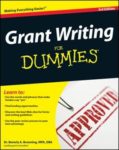 Another top pick for newbies, Amy also recommends Grant Writing for Dummies. She says, “This comprehensive guide is a perfect primer for those interested in grant writing but unsure where to start.” Written by an industry expert, this book dives into government grants, an area that many grant books do not cover.
Another top pick for newbies, Amy also recommends Grant Writing for Dummies. She says, “This comprehensive guide is a perfect primer for those interested in grant writing but unsure where to start.” Written by an industry expert, this book dives into government grants, an area that many grant books do not cover.
Of course, we don’t only read up on grant writing! Here are a few titles Elevate staff recommend to build a greater understanding of philanthropy and nonprofits:
And finally, because effective grant writing is as much about understanding the social context as it is about great writing, here are a few of our favorite books about social change:
What books have made you a better grant writer, leader, and changemaker? We’d love to hear from you!
August 18, 2020
Winning a grant is a major accomplishment for your organization! But in many cases, the work doesn’t end once you’ve received a check.
Funders often require their grantees to submit reports during the grant period, as a way of checking in on a grantee’s progress and how well they delivered on what they set out to do in their initial grant proposal. But more just just a requirement, grant reports are also an opportunity to build trust and rapport with funders, and begin laying the groundwork for an ongoing relationship and renewal grants down the road.
Whether you have a grant report to write in the near future, or you’re just looking for tips and advice to help you brush up on those skills for next time, keep reading for an overview of how to write a solid grant report that gives funders what they’re looking for.
The Basics: What is a grant report?
While it’s important to be updating your funders informally throughout the grant period as part of your overall stewardship efforts, a grant report is a formal means of updating a funder on what you have accomplished with their grant funding.
There are several different types of reports you’re likely to come across in your grant writing career, and different funders may ask for different combinations of these:
- A final report typically comes about 30 days after the end of the grant period
- An interim report or progress report typically comes about half-way through the grant period. (For multi-year grants, you may need to submit multiple progress reports, typically on an annual basis).
- Sometimes more frequent financial reports are also required. For example, public funders often require monthly financial reports
What are funders looking for in a grant report?
The Center for Effective Philanthropy frames a grant report as a key opportunity for funders to explore the space between what they hoped for from a grantee, and what actually happened. And through that lens, a grant report can serve many possible purposes, including:
- Accountability: to confirm grant money has been used for its intended purposes
- Documentation: a record of a grantee’s activities and history with the funder
- Grantee support and relationship building: part of an ongoing conversation with grantees about what they are learning and what they need
- Grantee assessment: to understand if a grantee is a priority for future funding or could benefit from capacity support and connections
- Grantmaker learning to inform decision-making: to determine if a funding strategy is effective and worthwhile
- Engage Others: sharing grantees’ data, stories and lessons with community stakeholders to encourage other investment
- Building a field: to contribute knowledge to a field of work, especially a newer one
Of course, different funders will have different purposes and expectations for your report depending on their priorities, staffing, and sophistication of their own strategies. To glean some insight into what a particular funder is looking for, one option would be to ask them directly how they use your reports — whether during your site visit, after the award is granted, or through the grant period. Once you have a better sense of how heavily this funder will be engaging with your report and what they’re specifically looking for, you can invest the appropriate amount of time and effort putting it together.
What goes in a grant report?
Many funders will provide specifications for what to include in your grant report, and in what format. However, if your funder hasn’t given you a set of specific guidelines to use, our recommended list of components to include is below!
First, every grant should start with a thank you. You’ll never see this show up in the funder’s template or guidelines for what to include, but make sure to include one anyway! You may have to be creative for how to fit this in, especially if you’re using an online portal. Sometimes you can include a cover letter as part of a pdf that gets uploaded, if that makes sense for your situation.
Additional components of a standard grant report can include:
- Grant Activities & Changes to Project Plan
- Results & Impact of the Project
- Challenges & Lessons Learned
- Financial Statement
- Sustainability & Future Plans
- Attachments
The secret ingredient for a memorable grant report: Storytelling
It’s a good idea to think about grant reports in terms of telling a powerful story. Compared to a grant proposal, a grant report is a great forum for leveraging the power of emotional appeal to sell a funder on your impact, and leave a strong impression. We often refer to the three-part storytelling framework below as a starting point, which dates back to ancient Greece:
Ethos — an appeal to ethics
For our purposes, this is about establishing credibility, This is where you’ll take the opportunity to remind your funder that you’re a credible organization and that you share their priorities and values; to demonstrate that you spent their funds responsibly; and to reassure them that they’ve invested in a feasible and important project that’s making a meaningful impact.
Logos — an appeal to logic
This is where your data and outcomes come into play! Using quantitative data in your reports helps create a clear structure, and paints an easy-to-digest picture of your program’s impact and success. It’s critical that you use facts to support your claims here.
Pathos — an appeal to emotion
Don’t go overboard with this part, but do keep in mind that this is your opportunity to really showcase how your programs are making a difference in your community. To do this well, use stories and quotes from your stakeholders, and highlight ‘real’ voices to show the more human side of your work and increase the persuasiveness of your report. This is especially relevant for direct service and more “charity”-based organizations.
—
You’ll need to find a balance between all three of these pieces, and that balance will vary based on each particular funder’s nature and priorities — but all three pieces of the framework are important.
How to collect stories for your grant reports
If you don’t already have systems in place for collecting stories from the people you service, below are a few tips to help you get started in this area:
- Work with your marketing team: find out what they’re already doing, to keep you from having to reinvent the wheel. For example, are they producing a newsletter (print or email) that includes client stories? These can be repurposed for grants! You may have to adjust the language slightly, but it gives you a place to start. Other questions to ask yourself might be: do you have an existing organizational video (including unused footage) that includes quotes? Do you ever ask participants to speak at fundraising events or participate in advocacy? These can also be great sources for powerful stories to include.
- Begin to build a repository of quotes and stories. The word “repository” might sound intimidating, but this can be as simple as a Word document that gets added to over time. You might also consider creating a system of ‘tags’ in your repository, to make it easier to find what you need later by topic and/or source.
- Talk to program staff about what types of stories you are seeking. It might be helpful to create a list of the specific types of stores you need based on your programs and typical reporting requirements, and ask your program staff to help you collect these specific types of stories as they’re working on the frontlines. Depending on how your team works best, you could also systematize this process a bit by asking them to send you stories on a quarterly (or otherwise regular) basis so that they remember to be on the lookout for them.
February 14, 2020
If you’re new to grant writing, figuring out how to write a grant proposal for the first time can seem convoluted, overwhelming, and stressful.
You might feel overwhelmed with questions: What information goes in which section? Am I providing enough data? How much money should we ask for? Does this funder accept unsolicited applications?
As a team of professional grant writers and institutional fundraisers, we’re no strangers to the sometimes-puzzling language of grant writing. After working with hundreds of nonprofit clients over our lifespan as a company, and securing millions of dollars for their programs from public and private funders alike, we’ve learned a thing or two about what constitutes a winning grant (and the mistakes to avoid).
Below are five crucial pieces of advice we’ve gleaned over the years in our work as grant writing professionals. These tips will help you avoid common grant writing mistakes, create a plan for writing and submitting your first grant, and make the strongest possible case for funding.
1. Grant writing is (often) a team effort
Even when you’re the only person at your organization writing grants or doing fundraising, you’ll still likely need to collaborate and work with other people at your organization at various stages along the way – including deciding on strategy, gathering information about your programs, editing, compiling the necessary attachments, and gaining final approval before submission. To that end, it’s important to establish a clear process internally, so everyone involved is clear on who’s doing what.
What your exact process looks like will depend on your organization’s specific setup and circumstances, though we do walk through some examples of what a common division of labor might look like in our popular webinar on How to Write Your First Grant.
2. Build in enough time to get the job done
Will you be requesting funding for a new program, or an existing program? Especially if the request is for a new program, make sure to build in extra time to develop any new language and get it approved by the right people. Similarly, it also doesn’t hurt to budget extra time to consult with your program team before you start writing. Talking through the specifics of the work that’s going to be done with this new program is a great way to make sure you’re all on the same page before you’re too far down the road of writing the proposal.
3. Read the RFP closely before you start writing
Specifically, look for the list of funder requirements up front. Do you meet ALL of them? Grant requirements are exactly that – If you meet all but one, you’re ineligible. It’s important that you check off all the requirements, and similarly, keep an eye out for any specific submission instructions. This could include things like mailing printed copies, any character limits or length requirements, or whether the deadline is a postmark deadline or a receipt deadline. One careless mistake here could disqualify you.
4. Plan ahead for any necessary attachments
The biggest thing to remember here is to only include the attachments that are required! As tempted as you or your Executive Director may be to throw in an extra brochure or a great video that really shows off the impact of your programs – unless the funder has given you the explicit option to attach program support materials, they do not want you to include them.
Follow the guidelines, and start your attachment planning early to build in as much time as possible. (At Elevate, we often recommend our Grant Writers start attachment planning before they even start drafting – especially if you need to coordinate with others to gather all the pieces.)
5. Highlight your credibility
Every piece of your proposal should bolster your credibility as an organization, and create the impression that would be a reliable grantee. You have a number of opportunities to make the right impression – including submitting a nicely presented and well-developed proposal, painting a clear picture of exactly how you’ll use their funding, pointing to any external signs of legitimacy that indicate you can deliver on your commitments (i.e., awards, news articles, publications, strong outcomes, etc.), and demonstrating a good reputation in your community. The more you can showcase these qualities and make the case for your credibility, the better.
October 28, 2019
As fundraisers who craft customized language each and every day, we are deeply aware of how words can be used to inspire, persuade, and inform others. However, we may not always be aware of the impact our language can have.
Research shows us that linguistic patterns can perpetuate real-life power disparities. Even small differences in language can reveal personal bias, beliefs, and perception of a situation or group of people.
While it may seem counterintuitive to mainly focus on the power of people when discussing their needs, here are a few key reasons to adopt empowering, strengths-based language in your fundraising strategy:
Empowering language reflects the full reality of those you serve.
Because language shapes perception, we have a responsibility to represent our constituent’s and their experiences wholly and truthfully – the way anyone would like to be represented when being introduced to a new party. The communities your organization serves are resilient, fully capable, and will persist with or without philanthropy. Every individual has their own agency, goals, and desires, and communities will always have existing networks in place to support their needs, therefore the stories we share should reflect that reality.
This doesn’t mean that there isn’t a need facing the community, but instead emphasizes that the need is not insurmountable. The need is not only multifaceted, but contextual. Reflecting on the real power of people through your choice of language is an essential part of building an empowering and authentic relationship between your community and your supporters.
Empowering language aligns with shifts in foundation priorities in the nonprofit sector.
With the understanding that language matters, many funders are choosing to lead the charge in adopting and modeling empowering language. Top institutional givers, such as Ford and the California Endowment, as well as young foundations like Echoing Green are shifting their priorities to focus on addressing issues of power and equity.
As fundraisers, using empowering language positions us to cultivate relationships with funders that positions us as advocates and educators for our communities, while also giving us the opportunity to respond to the shifting funding landscape. Choosing to use empowering language is one step towards building power and equity for your community – and can be a key method for demonstrating your alignment with funders’ interests.
Empowering language amplifies your mission.
Whatever your specific mission, your vision is built around serving a need in your community. Empowering language is a way of representing your organization and community. It is a method that can be applied across issue areas, interventions, and program structures.
Empowering language can amplify your mission because it serves to change the understanding of your work at a fundamental level – motivating others to see solutions rather than barriers. By focusing on the power, strength, and resources in your community, you are demonstrating how you are part of the solution, rather than part of the problem.
Want to continue the conversation about developing and using empowering language to advance equity?
Join Alison, LaTissia, and Sierra at the GPA National Conference on November 7th for a panel discussion for nonprofit professionals on how to use language strategically to build power for your constituents at every level of the fundraising process! To learn more about the topics that other Elevate staff will be presenting at the conference this year, stay tuned for upcoming blog posts.
Additional resources:
Written by Sierra Francis Perez and Alison Hight
This article was developed in conjunction with a presentation at the 2019 Grant Professionals Association Annual Conference created and led by Elevate staff.
October 28, 2019
Elevate is proud to share that several of our team members were selected to present three different breakout sessions at the upcoming Grant Professionals Association Annual Conference, which was held November 6-9, 2019 in Washington, DC!
Leading up to the conference, we’re sharing previews of these sessions, and some of what our presenters will be teaching. In this post, we’re looking at some of the complexities of fundraising for advocacy activities, particularly as they complement direct services, and how to craft compelling grant proposals that win funding for this type of work.
Many nonprofit organizations that aim to achieve social change by providing services to their communities have begun incorporating advocacy activities alongside their direct services.
But because the results of advocacy work are often long-term, and the context can get complicated very quickly, it can be difficult to write a compelling request for funding.
In this post, we’ll be taking a closer look at what advocacy work is and how it can complement direct service work, some of the challenges involved in fundraising for advocacy, and best practices for preparing compelling requests – all of which will help you find, pursue, and win more grants for your advocacy activities.
What is Advocacy? And how is it different from direct services?
The Alliance for Justice defines advocacy as any action that speaks in favor of, recommends, argues for a cause, supports or defends, or pleads on behalf of others. Advocacy is a powerful catalyst for change that can improve the laws, policies, and systems that impact entire communities. For the purpose of this article, we think of advocacy as systems change – in particular, policy change.
On the other hand, we define direct service as the provision of resources, programs, and benefits that work to address the symptoms of social problems and meet the immediate needs of your target population. Some common examples of direct services organizations include health clinics, food pantries, soup kitchens, and organizations that provide services like individual skills training or education, mentoring, or case management.
For direct services agencies, the most common types of advocacy are:
- Organizing – for example, building power at the base;
- Research – for example, gathering and presenting on-the-ground data;
- Educating decision makers – for example, meeting with policymakers to educate them about the issues affecting their communities;
- Educating the public about the legislative process – for example, amplifying the voices of people who benefit directly from an organization’s programs; and
- Lobbying.
Understanding the Funding Landscape, and the Challenges
There are many funders who recognize the synergies between direct service and advocacy, but there are many more (particularly at the local level) who are not well versed in the relationship between advocacy, direct service, and their own philanthropic goals. For this reason, fundraising for advocacy has several built-in challenges that are helpful to be aware of from the start.
For instance, local funders and foundations that are used to funding direct services may not always have the staff or the bandwidth to discuss specific proposals and advocacy strategies, to learn more about how an organization’s advocacy work aligns with their impact goals. Relatedly, these funders often shy away from funding advocacy because they conflate advocacy work with lobbying.
On the other hand, while there may be fewer funders willing to fund advocacy activities compared to direct services, the good news is that the funders who do fund advocacy often offer larger and/or multi-year grant awards, more general operating support, and a different (and often less-intense) focus on outcomes during the grant period – because they understand the nature of this type of work.
Of course, to win grant awards to support your organization’s advocacy work, you’ll have to prepare a persuasive proposal that makes a strong case for funding.
Best Practices for Crafting a Compelling Request for advocacy
When it comes to drafting a strong proposal, knowing how to frame your outcomes, goals, and objectives in the context of advocacy is often a major stumbling block. It may help to think of them as follows:
- Outcomes are the overarching changes you are hoping to bring about;
- Goals are the tangible steps that occur to make this change possible; and
- Objectives are the measurable activities you will implement to achieve the goal.
If we zoom out one step further, here is an example of how to approach some other key sections of your grant proposal when you’re requesting support for advocacy activities:
- Needs Statement – Demonstrate the need for advocacy
- Organizational Summary – Build your organization’s advocacy credibility
- Program Description – Spell out your key advocacy activities; do they tie in with your direct service?
- Goals, Objectives, and Outcomes – illustrate the systems change that will occur because of your work
In short, your objective in your grant application should be to clearly illustrate the change you’re hoping to achieve, how you expect that change will play out over time, and the role your organization will play in producing that change.
Written by Noura Hemady and Eric Spioch
January 10, 2019
Translating your organization’s work into a comprehensive yet concise proposal is no easy task.
To make things easier, we have compiled a list of recommendations based on our staff’s interactions and surveys conducted with Foundation staff. In this post, we share an insider’s scoop on tips and tricks to follow at every stage of the writing process from planning to proofreading.
Here are five strategies—straight from the nation’s leading funders—on how to write a grant proposal that stands out from the rest.
MAP IT OUT
- Outline your responses. Preparation is the most important stage in grant writing. It puts you on the right track for a strong draft—and saves a LOT of time in the long-run. Before drafting, use a few bullet points to identify the topics you want to cover in each section.
- Answer the question they’re asking—not the one you want them to ask. It’s simple enough, but funders frequently come across applications that do not answer the stipulated question, or attempt to use an answer that was tailored for a slightly different question. For example, a response to, “Describe the community need addressed by your program.” should only include the rationale behind your program—not the activities that are part of your program.
- Answer ALL parts of a question. It’s not uncommon to find multiple questions nested within a single section. For example, “Describe the outcomes that will be measured for each of the goals outlined above and whether evaluations will be internal or external.” is posed as a single question—but really requires you to discuss both outcomes and evaluation methodology. Pay close attention to these sections in your outline to avoid overlooking nested questions in your draft.
DON’T TAKE SHORTCUTS
- Write a unique answer for each section. Take advantage of the space you’re given to include as many details about your organization or project as possible. Using the same content to answer multiple questions signals to funders that you either didn’t understand the questions, or that your programs are not well-developed.
- Never use an old application. Write a fresh proposal when applying for renewed funding or when applying for a grant that you were previously denied. Funders want to see the growth and evolution of your organization.
…BUT DON’T TAKE THE SCENIC ROUTE EITHER
- Organize your thoughts: Each section of a response should serve a clear purpose. For example, if the first half of a paragraph is dedicated to describing the national scope of an issue, all information related to this topic should be included in that section—not scattered throughout the proposal.
- Condense your language: Funders don’t like reading unnecessarily long proposals. Keep your writing concise by replacing long phrases with one or two powerful words. For example:
- To measure the effectiveness of our program… à To evaluate our program…
- Students who are considering enrollment can… à Prospective students can…
KEEP IT SIMPLE
- Don’t overuse jargon. If you’re a nonprofit in the health sector and you’re writing to a small family foundation, phrases like “social determinants of health,” and “patient-centered outcomes” will likely fly over the funder’s head. Opt for simpler language. Or, simply limit your use of jargon and be sure to clearly define each term before introducing another.
- Don’t overuse abbreviations/acronyms. Let’s say you are writing a grant for the hypothetical nonprofit Future Markets for Tomorrow (FMFT). The sentence “Partnering with the ACLU advances FMFT’s BAA program.” can be confusing—especially if the full-form of each acronym was introduced several pages earlier. The sentence is more reader-friendly when re-written as, “Partnering with the ACLU advances our budget analysis and advocacy initiatives.”
- Never use the word funder. Grantmakers prefer to be referred to as partners, collaborators, allies, supporters, or investors. Referring to grantmakers as “funders” creates the impression that you see them as a piggy bank rather than a thought partner.
REMEMBER THE LITTLE THINGS
- Remember to delete all copy placeholders (i. “XXX”). Limit your use of copy placeholders to one or two types. (I generally use either square brackets or XXX in all my placeholders.) This allows me to easily use the Ctrl+F search feature when I’m reviewing the final draft to find any stray placeholders.
- Never submit a proposal with another funder’s name in the copy. If you’re adapting language from one proposal to use in other funding applications, carefully proofread each application to ensure that you’re writing to the right organization. Using the same search tool can be helpful here to confirm that the old funder’s name is no longer in the application.
- Never write to the wrong person. Check the funder’s website or IRS Form 990 to verify that you have the correct name and title of the person you’re writing to.
- Clearly label your attachments. Funders prefer attachments to be labeled with both your organization’s name and the file type. (Example: United Way 2018 Audit).
February 8, 2018
The sustainability section of a grant proposal is always somewhat tricky, if not slightly ironic. You must make the case that your organization or program will be fine if you do not win the grant, but that you do still need the funding.
In general, this section should be an explanation of where other funding will come from to support your work as an organization. Foundations will rarely be your sole funding source; you will need to demonstrate money is coming from other sources and that your program can sustain itself over the long term.
To paint a full and accurate picture of your organization or program’s sustainability, you should provide details about your strategic plan, fundraising plan, fundraising streams, and program expansion and changes. And because it can be difficult to know exactly where to start or what to include, we’ve listed some key phrases and concepts below that can help you tackle this tricky section of your proposal with confidence.
Diversified Funding
Your organization supports its work through some combination of earned income, individual contributions, government contracts, and philanthropic support. In some cases, this is even a consistent ratio. The strongest case for diversified funding provides some specific percentages and comments on the stability of each funding stream.
Multi-Year Funding
Multi-year funding is a nonprofit holy grail. If you have it, be sure to tell your funders that at least a portion of your revenue is committed for multiple years!
Renewed Funding
Does your organization renew a significant proportion of its funding every year? If so, you will want to provide those stats.
For example:
“The organization has received renewed funding from 15 long-time organizational supporters for each of the last three years.”
Annual/Strategic Planning
If you’ve already established that your organization has strong planning processes in the Leadership section of the grant, then mentioning that a particular program or initiative is included in the annual or strategic plan is an indicator of sustainability.
For example:
“Doubling the number of children served through our program is a key goal in our 2012-2016 strategic plan and therefore a focus of our fundraising.”
Development Capacity
For those organizations who rely heavily on institutional fundraising or individual giving (i.e. they do not have government contracts or earned income streams), it is important to emphasize their capacity for fundraising. This is particularly important for organizations proposing a programmatic expansion or another change that will increase the fundraising burden.
With organizations who are working with Elevate, we emphasize that they have dedicated development staff that research and apply to new funding sources. If your organization has had a lot of success identifying new funding, provide that information; for example, development staff have successfully applied to 10 new funders in the last year.






 Stories—whether shared verbally, in writing, or through images—have the power to move people to take action. But with this potential to persuade, there is also a high risk of incorporating bias into narratives. Storytellers have the power – whether intentional or not – to inflict harm on the people who are the subjects of their stories.
Stories—whether shared verbally, in writing, or through images—have the power to move people to take action. But with this potential to persuade, there is also a high risk of incorporating bias into narratives. Storytellers have the power – whether intentional or not – to inflict harm on the people who are the subjects of their stories.  On the EthicalStorytelling.com site, you can find a set of six underlying values, an
On the EthicalStorytelling.com site, you can find a set of six underlying values, an  This is because ChatGPT lacks the context, experience and judgment to handle such complex work. Even when I asked ChatGPT “What are the Pros and Cons of Using ChatGPT for grant writing?” it didn’t disagree! While ChatGPT praised its speed and ability to maintain consistency in “tone, language, and messaging” across various sections of a grant proposal and to polish language, it cautioned that it may not fully appreciate the “nuances” of grant guidelines, that it has limitations in understanding the context of an organization’s work and history, and that it could also produce plagiarizing text.
This is because ChatGPT lacks the context, experience and judgment to handle such complex work. Even when I asked ChatGPT “What are the Pros and Cons of Using ChatGPT for grant writing?” it didn’t disagree! While ChatGPT praised its speed and ability to maintain consistency in “tone, language, and messaging” across various sections of a grant proposal and to polish language, it cautioned that it may not fully appreciate the “nuances” of grant guidelines, that it has limitations in understanding the context of an organization’s work and history, and that it could also produce plagiarizing text.  I know what you are thinking: It’s no surprise that a grant writing firm is telling me not to use an AI tool to write grants! But we are not just saying this because we want to be your grant writers. (Though we DO want to be your grant writers!)
I know what you are thinking: It’s no surprise that a grant writing firm is telling me not to use an AI tool to write grants! But we are not just saying this because we want to be your grant writers. (Though we DO want to be your grant writers!)  At Elevate, some of our staff are experimenting with the use of AI-powered tools such as
At Elevate, some of our staff are experimenting with the use of AI-powered tools such as  For these reasons, think carefully about what information you share with AI tools. Remember that a grant application may include information about your organization, programs, staff, and future plans that might be considered private.
For these reasons, think carefully about what information you share with AI tools. Remember that a grant application may include information about your organization, programs, staff, and future plans that might be considered private.
 We paired Calvary with one of our
We paired Calvary with one of our 

 Amy describes
Amy describes 


